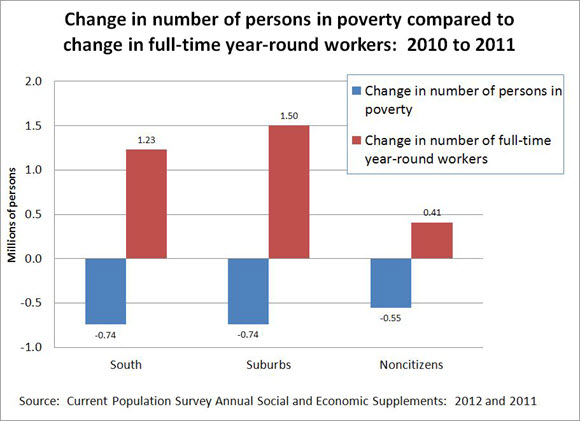
An official website of the United States government
Here’s how you know
Official websites use .gov
A .gov website belongs to an official government organization in the United States.
Secure .gov websites use HTTPS
A lock (
) or https:// means you’ve safely connected to the .gov website. Share sensitive information only on official, secure websites.
-
//
- Census.gov /
- Census Blogs /
- Random Samplings /
- 2011 Poverty - Stories Behind the Numbers
2011 Poverty - Stories Behind the Numbers
2011 Poverty - Stories Behind the Numbers
In 2011, 15.0 percent of the population had income below the official poverty thresholds. Between 2010 and 2011 there was no statistically significant change in the percent or number of people in poverty in the United States. This was the first time in four years that the poverty rate did not go up. End of story? Well, not quite. We can look beyond these broadest poverty estimates to understand some important things happening in the economy.
There were three major demographic groups for whom both the poverty rate and the number of people in poverty decreased. In the South, the number of poor people went down by 743,000 and the poverty rate declined by .8 percentage points. The number of people in poverty in the suburbs fell by 739,000 and the suburban poverty rate fell from 11.9 percent to 11.3 percent. The number of noncitizens in poverty also decreased by 551,000 and their poverty rate fell from 26.8 percent to 24.3 percent. There were also statistically significant declines in the poverty rates for men and Hispanics. (Since the total number of people in each of these groups grew, the drop in these poverty rates did not result in fewer men or Hispanics in poverty.)
What factors were pushing the poverty rates down for these groups? Increases in the number of people working full-time year-round go a long way in explaining the drops in poverty. The number of people reporting full-time year-round employment increased by 1.2 million in the South and by 1.5 million in the suburbs. There were 411,000 more noncitizens working full-time year-round in 2011 than in 2010. Of the 2.2 million additional people working full-time year-round, 1.7 million were men and 959,000 were Hispanic. While Hispanics make up about 15 percent of the working age population, they accounted for more than 40 percent of the increase in full-time year-round employment.
Looking at the entire nonelderly adult population (those between the ages of 18 and 64), there were no statistically significant changes in the number of people in poverty or the poverty rates. The change for this group was in the distribution of workers between full-time, year-round and less than full-time, year-round. The overall number of workers grew by a modest 476,000 but the number of full-time, year-round workers grew by 1.7 million. The number of less than full-time, year-round workers shrank by 1.3 million. All things equal, more full-time year-round workers means lower poverty.
We also see some evidence that the public safety net lowers poverty rates. As in past years, Social Security was by far the most important anti-poverty program. Social security benefits kept the cash income of more than 20 million individuals over the poverty threshold. Unemployment insurance kept another 2 million people out of poverty.
Share
 Yes
Yes
 No
NoComments or suggestions?


Top

